 Film society brochure, 1956-57
Film society brochure, 1956-57 The 2 outer pages of a single-leaf brochure.
Front and back of the 1956-57 brochure for 'Aonáid Scannán [sic], Ċoláiste Iolscoile na Gailliṁe', or Education Film Unit of University College Galway, which was the forerunner of the present FilmSoc. Established in 1947 by Pat Larkin, Professor of Education, the Unit brought films to Galway where they were projected in An Taibhdhearc.
As this brochure shows, members were also invited to join in making short films on location. The membership fee was 20 shillings (£1) with a concessionary rate of 15 shillings for students. £1 in 1956 has been estimated as equivalent to between £24.86 and £31.93 (€29.04 and €39.63) in 2023. In 1956 a professor's stipend was £1,450 on appointment, increasing to a maximum of £1,800. The fee charged to students implies that they were thought to be relatively well off.
 Governing Body of UCG, 1983-86 / Coiste Rialaithe Choláiste na hOllscoile, 1983-86
Governing Body of UCG, 1983-86 / Coiste Rialaithe Choláiste na hOllscoile, 1983-86 An official photograph, taken in June 1983, of the members of the Governing Body of UCG in office for the period 1 February 1983 - 31 January 1986, together with the two senior members of administrative staff who serviced it. Missing from the photograph are M.P.J. ('Bobby') Curran (elected by the Graduates), Eugene Henry (elected by Sligo Co. Council), Professor Seán M. Lavelle (elected by Academic Council), Seán McEvoy (elected by Mayo Co. Council) and Pascal McKeon (elected by Leitrim Co. Council).
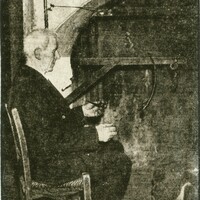 Seanchaí ag innsint a Sgéil (Seanchaí (traditional Irish story-teller) telling his Story).
Seanchaí ag innsint a Sgéil (Seanchaí (traditional Irish story-teller) telling his Story). An undated laminated Irish Independent photograph of Seán Rua Ó Beaglaoich of Gort an Chaltha (near Mionloch), Co. na Gaillimhe taking part in the Comórtas Scéalaíochta (storytelling competition) of Oireachtas na Gaeilge at the Abbey Theatre, Dublin. The performance of the Seanchaí is, in order to make the environment more authentic, staged against the simulated background of a traditional Irish open fireside, including a fire crane and pot hooks for cooking potatoes etc in pots over the fire, as well as what appears to be a fire burning brightly. The Seanchaí is, again appropriately, seated on a traditional súgán (straw-rope) chair.
Seán was employed by the University from 1949 to 1955 as a Seanchaí, following the death of Pádraic Ó Meadhra, the first Seanchaí (1932-48), to give six one-hour classes weekly during the Session. Before being allowed to enter any University or College examination, students had to have attended a Conversation Class in Irish in the College for one hour a week in each week in the preceding Session, and all degree examination candidates (except those with Irish as a degree subject) had to have passed an oral examination in Irish by the University Examiners in Irish and demonstrated the ability to converse in Irish on ordinary subjects before presenting for examination. In that connection, Conversation Classes in Irish were conducted by native speakers of Irish, such as Seán, under the direction of of the Professor of, and the Assistants in, Irish for 17 hours each week during the Session. / Grianghraf lannaithe de chuid an Irish Independent de Sheán Rua Ó Beaglaoich ó Ghort an Chaltha (gar do Mhionloch), Co. na Gaillimhe agus é mar iomaitheoir sa Chomórtas Scéalaíochta ag Oireachtas na Gaeilge in Amharclann na Mainistreach, Baile Átha Cliath. Bhí Seán fostaithe ag an Ollscoil ó 1949 go 1955 mar Sheanchaí, i gcomharbacht ar Pháraic Ó Meadhra, an chéad Sheanchaí (1932-48). Bhí air sé rang, uair an chloig an ceann, a thabhairt gach seachtain ar feadh an tSeisiúin. Ní raibh de chead ag mic léinn cur isteach ar aon Scrúdú Ollscoile nó Coláiste gan freastal a bheith déanta acu ar ranganna Comhrá uair an chloig sa tseachtain i rith an tSeisiúin roimh an Scrúdú, agus ní raibh de chead ag mic léinn (seachas iad siúd a raibh Gaeilge mar ábhar céime acu) cur isteach ar a scrúdú céime murar éirigh leo roimh ré i scrúdú béil ag Scrúdaitheoirí Gaeilge na hOllscoile agus murar léiríodar go rabhadar in ann labhairt i nGaeilge ar nithe coitianta. Maidir leis sin, bhi Ranganna Comhrá sa Ghaeilge ar siúl ar feadh seacht n-uaireanta déag sa tseachtain i rith an tSeisiúin agus cainteoirí dúchais ar nós Sheáin ina mbun, faoi cheannas Ollamh na Nua-Ghaeilge agus Cúntóirí na Gaeilge.
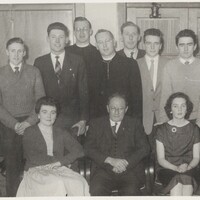 An Cumann Éargna Aicionta in the early 1960s
An Cumann Éargna Aicionta in the early 1960s A picture of the members of Cumann Éargna Aicionta (Science Society) taken likely in the early 1960's, is shown below. It includes An t-Ollamh Cilian Ó Brolcháin who was Professor of Experimental Physics (1934-1973).
Pictured here from left to right:
Back row: Donal McNally; John White; Máirtín ÓMaoldúin (?); Br. ÓBuachalla; Br. Gallagher; Tom O’Connor; Donal Carroll; Seán McDonagh; Sean de Róiste
Front row: Máire NicAmhlaibh; An t-Ollamh Cilian Ó Brolcháin; Catherine / May Dineen (?)
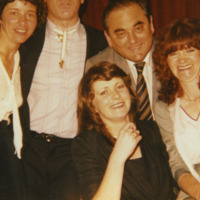 Administrative Staff social outing, 1970s
Administrative Staff social outing, 1970s A social outing for members of Administrative Staff in Flannery's Hotel in the 1970s.
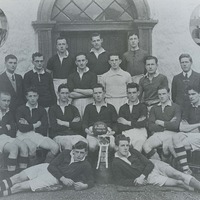 UCG Sigerson Cup Champions, 1933-4.
UCG Sigerson Cup Champions, 1933-4. This was the UCG team which won the Sigerson Cup, the annual Gaelic Football Championship for the Irish Universities, in 1933-4, for the third time; the previous triumphs were in 1911-2 and1921-2. This started a glorious run of success: eight out of nine titles between 1933-4 and 1941-2, and a record, still standing, of six in a row between 1936-7 and 1941-2. The competition was hosted by UCG that year, and all the games were played over a weekend in the Sports Ground. In the semi-final, on 9 December 1933, they beat QUB by 4-7 to 1-6, with their captain, Mick Higgins, in bed with a cold; and in the final, on 10 December 1933, they beat UCD (victors over UCC in the other semi-final) by 5-6 to 2-3, thereby foiling UCD's bid for six successive titles.
Several of this team won All-Ireland medals with Galway or Mayo in the years immediately thereafter, with Mick Higgins captaining the Galway champions of 1934 and Séamus O'Malley captaining the Mayo champions of 1936.. Donal McAnallen says that 'they built probably the greatest legacy of any University Gaelic football side through Sigerson Cup and county championship successes, their part in Galway's All-Ireland SFC glories of 1934 and 1938, and their part in Mayo's All-Ireland win of 1936 - including the Mayo captain, Séamus O'Malley - and, in the amazing run of seven NFL titles (sc. for Mayo) in eight years (1933-41)'.
That team's role in the adoption of the present Galway team colours should also be mentioned. Jim Carney writes that 'on September 15th 1934, eight days before the All-Ireland SFC final between Galway & Dublin, it was announced that Galway would be changing their colours from green & white to maroon & white. The change was influenced by UCG's Sigerson Cup victory in the 1933-34 season & they were also the reigning county senior football champions. UCG's colours were maroon & white. The man who captained UCG to those two titles was also the Galway captain, Kilkerrrin's Mick Higgins. The switch to maroon brought luck with it, Galway defeated Dublin in the 1934 All-Ireland SFC final. The Galway county hurlers also switched from green & white to maroon & white. From then on, Maroon & White became the famous colours associated with Galway GAA.'
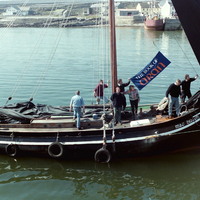 Aran book launch 1994, the Mac Duach hooker
Aran book launch 1994, the Mac Duach hooker When The Book of Aran was to be launched on Inishmore in 1994, its editors decided to bring copies of the book across from Kinvara in the Galway hooker Mac Duach.
Among the people seen here are Anne Korff (leaning against the mast), one of the book's editors, with two of the contributors: Paul Walsh (holding one end of the banner) and Gordon Darcy (foremost in the prow).
This is one of 31 photos taken by Frank Imbusch on the day of the launch which was attended by numerous members of NUIG staff.
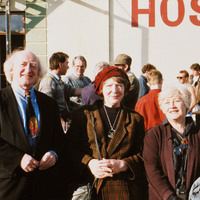 Aran book launch 1994, distinguished guests
Aran book launch 1994, distinguished guests Among those present at the launch of The Book of Aran on Inis Mór (Inishmore) in 1994, were Michael D. Higgins, Sabina Higgins and Mary Imbusch, seen here in the foreground of the photo. Michael D. Higgins was at the time Minister for Arts, Culture and the Gaeltacht (an tAire Ealaíon, Cultúir agus Gaeltachta), a position he held from 1993 to 1997. Another prominent politician who travelled to Aran for the launch was Proinsias De Rossa, leader of Democratic Left.
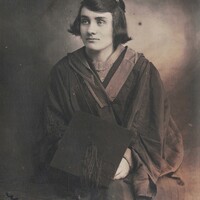 Ciss Byrne Graduation
Ciss Byrne Graduation Brigid Mary (Ciss) Byrne, daughter of Patrick Byrne and Cecily Morris was born in Vicar Street, Tuam on 19 Aug 1900. She went to Loreta, Stephen’s Green, Dublin. From there she went to University College Galway in 1918, with her name appearing in the list of students for the academic year 1918 – 19. She graduated in 1921 with a 1st class B. Comm. Degree and she obtained a B.A. degree with 2nd class honours in French and Irish in the autumn of 1922 (UCG calendars).
She became friendly with the Carlos sisters at the University. After qualification she got a job at the Galway VEC, known as ‘The Tech’. It was then divided into a Boys and Girls section and Ciss was the Girl’s Headmistress up to her retirement. She passed away on 1 January 1993, aged ninety two years of age. She is buried in the Byrne Family Grave in Tuam Cemetery.
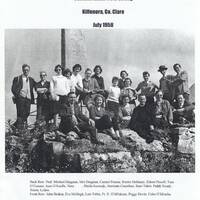 Cumann Éinde Field outing to Kilfenora, Co. Clare
Cumann Éinde Field outing to Kilfenora, Co. Clare A Cumann Éinde Field outing to Kilfenora, Co. Clare took place in July 1958. Names of participants are given below:
Pictured here from left to right are:
Back row: Prof. Michael Duignan; Mrs. Duignan; Carmel Fenton; Róisín Mullaney; Eileen Powell; Tom O’Connor; Joan O’Keeffe; Nora - ; Shiela Kennedy; Harriette Counihan; Sean Tobin; Paddy Keady; Jimmy Lydon
Front row: John Heskin; Eva McHugh; Lois Tobin; Fr. E. ÓhEideáin; Peggy Devitt; Colm Ó hEocha
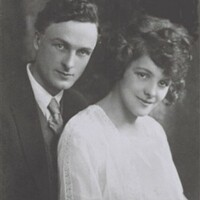 Delia Murphy and Thomas Joseph Kiernan
Delia Murphy and Thomas Joseph Kiernan Delia Murphy was born on 16 February 1902 at Ardoe, Claremorris, Co. Mayo. Delia was educated at the local primary school, then at the Dominican Convent, Eccles St., Dublin, where she was taught singing by Mother Clement Burke. She went to UCG in 1920 and graduated with a B.Comm. degree in 1923 (Special Collections). While studying for her degree, she sang at student and minor concerts. She married Thomas Joseph (T.J. / Tommy) Kiernan, civil servant, on 24 February 1924. She died in St Kevin's Hospital, Dublin, on 12 February 1971 (civilrecords.irishgenealogy.ie).
Delia Murphy was the second of eight daughters of John Murphy and Anna Agnes Fanning. She dated her introduction to traditional Irish ballads from her primary school days to the ballads she learned from Tom Maughan, a local itinerant boy who taught her to sing ‘If I were a blackbird’.
Shortly after their marriage, T.J. Kiernan was appointed secretary to the Irish High Commission in London, and during their time there, their four children were born: Blon, Naula, Colm, and Orla. In 1935 the family returned to Dublin where T.J. Kiernan took up the post of Director of Broadcasting at Radio Éireann, which he held on secondment until 1939. During these years, Delia's singing career reached its heights, when she recorded almost 100 songs with HMV. From this time until the mid-1950s, she was the most important exponent of Irish ballad singing to reach an audience on an international scale. She broadcast numerous times from Radio Éireann, becoming a household name. She wrote many of the songs herself and attributed much of her inspiration to itinerants' songs. Songs she made famous included ‘The spinning wheel’, ‘I'm a rambler, I'm a gambler’, and ‘Three lovely lassies from Bannion’, (Wikipedia/Delia Murphy).
She accompanied her husband on all his postings (Dictionary of Irish Biography), (doi.org/10.3318/dib). In 1941, T.J. Kiernan was appointed Irish Minister to the Vatican. In 1946 the Holy See made her a Dame of the Holy Sepulchre. 1946 saw the Kiernans posted to Canberra, Australia; 1952, Bonn, West Germany; 1957, Ottawa, Canada; 1961, Washington, DC, USA. Delia did not spend a lot of time in Washington, and lived on the family farm in Ottawa. It was while they were in Washington that Delia recorded her last record, The Queen of Connemara, the only LP she made. When her husband died (December 1967), Delia stayed in Ottawa and it was there that she gave her last concert at Camp Fortune in the Gatineau Hills. In November 1969 she sold the farm and returned to Dublin, where she purchased Liscannor Cottage, Chapelizod. She died in St Kevin's Hospital, Dublin, on 12 February 1971.
A picture of the Engineering Graduation Class of 1956 is shown.
Class names are given below which includes William Hillary Prendergast, whose biographical details are given (William Hillary Prendergast, Asset Id 13732).
Pictured here from left to right:
Back Row: Paddy Hoare; Con McCawley; Joe Kinneen; George Lee; Unidentified
Third Row: Frank Furey; Joe Dalton; Tom O’Sullivan; Des Sweeney; Gerry Mahony
Second Row: John Considine; Joe Curley; Brian Murphy; Prof. Willie Prendergast; Seán McDermott; Michael Lee; Tom Codyre; Pat Flood; Ernie Hession
Front Row: Michael Higgins; Pat Keating; Dickie Roche; Tom Leyden; Enda Conway; Seamus Martin; Johnny Donnelllan; Seamus Horan
 Frances Moffett Graduation Portrait
Frances Moffett Graduation Portrait Frances Moffett was born in Dunlo Street, Ballinasloe. Co. Galway on 4 Oct 1900. The family moved to Gentian Hill, Galway on 18 Dec 1908. She went to UCG in September 1919 and she graduated in September 1922 with a 1st Class Honours BA Degree, followed by a Higher Diploma in Education with 2nd Class Honours in 1923 (UCG Calendars). She left Ireland in 1924, never to return there to live. She joined the teaching profession in England until about 1936, and then trained for full-time work in the Church of England, later becoming Vice-Principal of a Women’s Theological College (Wikipedia, Frances Moffett, Jan., 2024).
Frances Moffett, daughter of Arthur Moffett, veterinary surgeon, and Jane Dods was the eldest of five children of a Presbyterian family. She attended the H School in Galway under Presbyterian management, but after a year was placed in the Model School, built for the training of Protestant pupil teachers. She went to UCG in September 1919 taking as her subjects - Experimental Physics, Mathematics and English for the BA. She joined the teaching profession in England, later becoming Vice-Principal of a Women’s Theological College. Retiring from Church work in 1960, she returned to teaching in schools and in a College of Education. In 1985, she published a memoir ‘I also am of Ireland’ of the first 24 years of her life. Frances Moffett passed away in 1992 (www.freebmd.org.uk) in the District of Merton, Greater London (B. Lally, Ballinasloe Life, Feb 2021, pp 59-60).
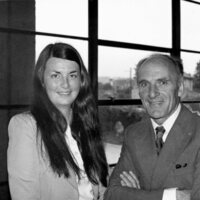 Máire Geoghegan Quinn and Declan Larkin
Máire Geoghegan Quinn and Declan Larkin A picture taken of Máire Geoghegan Quinn and Declan Larkin at UCG during an International Conference on Atmospheric Aerosols, Condensation and Ice Nuclei held at the University in September 1977. She was Parliamentary Secretary at the Department of Industry, Commerce and Energy at the time and later Minister of Justice (Wikipedia, Geoghegan-Quinn, Aug. 2023), while Declan Larkin was Professor of Electron Physics in the Department of Experimental Physics.
Declan Larkin was Lecturer in Experimental Physics (1947-1965); then Professor of Electron Physics (1965-1986); and Registrar (1974-1980)
 Margaret (Peggy) Burke Graduation, 1921
Margaret (Peggy) Burke Graduation, 1921 Margaret Mary Josephine (M.J.) was born on 20 March 1901 in Shrananagh, Co. Sligo. She won a Sligo County Council Scholarship and went to UCG in 1918. She obtained a 1st Class Honours B.A. degree in 1921 and obtained a H. Dip. In Education in 1922 (Calendars, Archives & Special Collections).
Margaret (Peggy) Mary Josephine (M.J.) Burke was born on 20 March 1901 (www.irishgenealogy) in Shrananagh, Co. Sligo to parents Martin (a school teacher) and Bridget Beirne. She won a Sligo County Council Scholarship in 1918 and came to UCG, as shown on the Student List for 1918 – 1919. She obtained 1st Class Honours in Irish and French and 2nd Class Honours in English & Logic in 1st Arts in the Summer of 1919. She obtained a pass in English as a subsidiary subject in summer 1920 for the Honours B.A. Degree. She was jointly awarded the ‘Dr. And Mrs. W.A. Browne’ Scholarship in the 1920 – 21 Session. She obtained 1st Class Honours in her B.A. Degree in 1921 and was awarded a Post-Graduate Scholarship in the Faculty of Arts. She obtained the Higher Diploma in Education in the summer of 1922.
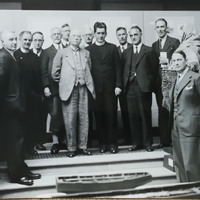 In the National Museum of Ireland, 1937
In the National Museum of Ireland, 1937 This photograph of distinguished Celtic scholars, folklorists, archaeologists and linguists, was taken in the National Museum of Ireland, Dublin. Two of those present had connections with the University of Galway: Eric Mac Fhinn (third from left) was appointed to UCG in 1931 as the the first lecturer in Education through the medium of Irish, and Proinnsias Mac Giollarnáth, one of the sons of Seán Mac Giollarnáth, noted folklorist (1st from left) was later Professor of Romance Languages from 1959 to 1987.
Present in this photograph, as noted on the reverse, are:
'Left to right: Seán Mac Giollarnáth, D.J.; Seamus de Largy; Fr Eric Fair (Mac Fhinn); Adolph Mahr; Osborne Bergin; Leon Ó Broin; Chairman of Commission: Cú Uladh, Aodh ? McGinley; Liam Price, D.J.; Fr Lorcan Ó Muirí; --- Hartmann ?; --- ; --- ; Micheal Ó hĖanaigh, Asst. I. A antiquities; Prof. Oke [Åke] Campbell, Upsala'
The two unidentified men in this list have been named as Louis Maguire and John O'Neill (History Ireland, 2013).
The Irish Folklore Commission met in Dublin in 1937. The Director of the National Museum, Adolf Mahr, and the noted linguist and Celtic studies expert Hans Hartmann were Nazi sympathizers, at a time when Nazi propaganda sought to make use of Celtic studies.
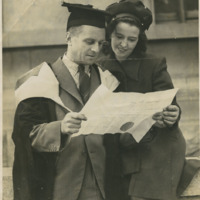 Lábhras Ó Nualláin doctoral conferring, with wife Frances
Lábhras Ó Nualláin doctoral conferring, with wife Frances Prof. Labhrás Ó Nualláin and his wife Frances at the conferring of his D.Econ. Sc. at UCD in 1953. Labhrás Ó Nualláin was a lecturer in and subsequently Professor of Economics at UCG. Here, dressed in academic robes, he is showing his wife Frances his doctoral parchment.
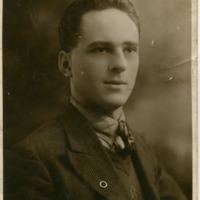 Prof. Lábhras Ó Nualláin wearing Fáinne
Prof. Lábhras Ó Nualláin wearing Fáinne This image depicts a young (age unspecified) Labhrás Ó Nualláin, who served as Professor of Economics at UCG between 1970 and 1982. It appears to be a studio portrait, although the photographic studio is not identifiable. The subject is wearing a tweed jacket, and on his right lapel wears a Fáinne. This is a circular pin (made from gold), worn to signify that the wearer is an Irish speaker. In later years different classes of Fáinne were introduced, i.e. a gold pin (Fáinne Óir) was worn by fluent speakers, and a silver pin (Fáinne Airgid) was worn by those with a basic or moderate fluency in the language. At the time Ó Nualláin received his pin there was only one category of pin, the Fáinne Óir.
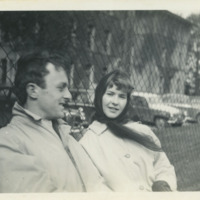 Eoin and Niamh Ó Dochartaigh
Eoin and Niamh Ó Dochartaigh An image of Dr Eoin Ó Dochartaigh and his wife Niamh (née Ní Nualláin) seated side by side beside the tennis courts at UCG. In the background can be seen the wire mesh fence surrounding the tennis courts (which is now a car park) in front of what is now the Education Department at the University of Galway. The image must have have been taken in the autumn or winter, as both subjects are wearing coats, and Niamh Ó Dochartaigh is wearing a headscarf.
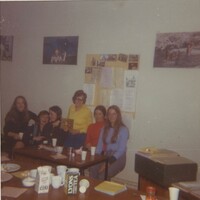 Tea party in the Information Office in the Quadrangle, 1970s
Tea party in the Information Office in the Quadrangle, 1970s Informal tea party for administrative staff of the Information Office in their office on the left side of the Archway at the entrance to the Quadrangle.
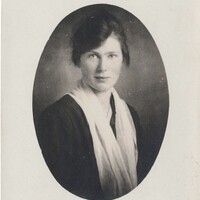 Martina Loughney Portrait, 1921
Martina Loughney Portrait, 1921 Martina Mary Loughney was born in Killala, Co. Mayo on 17 Dec 1901 (www.irishgenealogy.ie) to parents Martin Loughney and Ellen Timlin. She was awarded a Mayo County Council Scholarship in 1920 and went to UCG as also confirmed through being on the 1920 – 1921 List of UCG students. She obtained a 1st Class Honours B.A. degree and a B. Comm. degree in 1923.
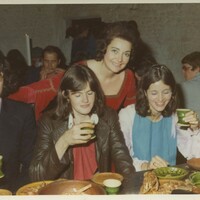 Staff social outing to Bunratty Castle, mid-1970s
Staff social outing to Bunratty Castle, mid-1970s A social outing for administrative staff to a Bunratty Castle banquet.